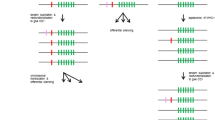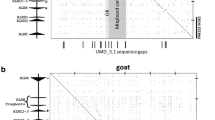Abstract
The Ly49 family of natural killer (NK) receptors is encoded by a highly polymorphic multigene family in the mouse and is also present in multiple copies in the rat. However, this gene exists as a single copy in primates and is mutated to non-function in humans. We recently showed that the cow also likely has only one Ly49 gene, but it is unclear what the Ly49 gene content is for other mammals. We have now isolated Ly49 cDNAs from the domestic cat, dog and pig and show that the corresponding gene appears to be single copy in these three species. The open reading frame is intact in all the genes and the putative proteins contain an immune tyrosine-based inhibition motif (ITIM), suggesting a role as an inhibitory receptor. In contrast to the other mammals, several Ly49-like genes appear to exist in the horse, indicating that amplification of this locus has occurred in a non-rodent lineage. Finally, phylogenetic analysis suggests that the rodent Ly49 genes have evolved more rapidly than their counterparts in mammals where the gene has remained as a single copy.





Similar content being viewed by others
References
Barten R, Trowsdale J (1999) The human Ly-49L gene. Immunogenetics 49:731–734
Barten R, Torkar M, Haude A, Trowsdale J, Wilson MJ (2001) Divergent and convergent evolution of NK-cell receptors. Trends Immunol 22:52–57
Braud VM, Allan DS, O'Callaghan CA, Soderstrom K, D'Andrea A, Ogg GS, Lazetic S, Young NT, Bell JI, Phillips JH, Lanier LL, McMichael AJ (1998) HLA-E binds to natural killer cell receptors CD94/NKG2A, B and C. Nature 391:795–799
Brown MG, Scalzo AA, Matsumoto K, Yokoyama WM (1997) The natural killer gene complex: a genetic basis for understanding natural killer cell function and innate immunity. Immunol Rev 155:53–65
Dissen E, Ryan JC, Seaman WE, Fossum S (1996) An autosomal dominant locus, Nka, mapping to the Ly-49 region of a rat natural killer (NK) gene complex, controls NK cell lysis of allogeneic lymphocytes. J Exp Med 183:2197–2207
Felsenstein J (1985) Confidence limits on phylogenies: an approach using the bootstrap. Evolution 4:783
Felsenstein J (1993) PHYLIP (Phylogeny Inference Package) version 3.5c. Distributed by the author. Department of Genetics, University of Washington, Seattle
Hershberger KL, Shyam R, Miura A, Letvin NL (2001) Diversity of the killer cell Ig-like receptors of rhesus monkeys. J Immunol 166:4380–4390
Hurst LD (2002) The Ka/Ks ratio: diagnosing the form of sequence evolution. Trends Genet 18:486–487
Khakoo SI, Rajalingam R, Shum BP, Weidenbach K, Flodin L, Muir DG, Canavez F, Cooper SL, Valiante NM, Lanier LL, Parham P (2000) Rapid evolution of NK cell receptor systems demonstrated by comparison of chimpanzees and humans. Immunity 12:687–698
Lanier LL (1998) NK cell receptors. Annu Rev Immunol 16:359–393
Long EO (1999) Regulation of immune responses through inhibitory receptors. Annu Rev Immunol 17:875–904
McQueen KL, Parham P (2002) Variable receptors controlling activation and inhibition of NK cells. Curr Opin Immunol 14:615–621
McQueen KL, Wilhelm BT, Harden KD, Mager DL (2002) Evolution of NK receptors: a single Ly49 and multiple KIR genes in the cow. Eur J Immunol 32:810–817
Madsen O, Scally M, Douady CJ, Kao DJ, DeBry RW, Adkins R, Amrine HM, Stanhope MJ, de Jong WW, Springer MS (2001) Parallel adaptive radiations in two major clades of placental mammals. Nature 409:610–614
Mager DL, McQueen KL, Wee V, Freeman JD (2001) Evolution of natural killer cell receptors: coexistence of functional Ly49 and KIR genes in baboons. Curr Biol 11:626–630
Makrigiannis AP, Pau AT, Schwartzberg PL, McVicar DW, Beck TW, Anderson SK (2002) A BAC contig map of the Ly49 gene cluster in 129 mice reveals extensive differences in gene content relative to C57BL/6 mice. Genomics 79:437–444
Mouse Genome Sequencing Consortium (2002) Initial sequencing and comparative analysis of the mouse genome. Nature 420:520–562
Murphy WJ, Eizirik E, Johnson WE, Zhang YP, Ryder OA, O'Brien SJ (2001) Molecular phylogenetics and the origins of placental mammals. Nature 409:614–618
Rajalingam R, Hong M, Adams EJ, Shum BP, Guethlein LA, Parham P (2001) Short KIR haplotypes in pygmy chimpanzee (Bonobo) resemble the conserved framework of diverse human KIR haplotypes. J Exp Med 193:135–146
Saitou N, Nei M (1987) The neighbor-joining method: a new method for reconstructing phylogenetic trees. Mol Biol Evol 4:406–425
Sawicki MW, Dimasi N, Natarajan K, Wang J, Margulies DH, Mariuzza RA (2001) Structural basis of MHC class I recognition by natural killer cell receptors. Immunol Rev 181:52–65
Takei F, Brennan J, Mager DL (1997) The Ly-49 family: genes, proteins and recognition of class I MHC. Immunol Rev 155:67–77
Thompson JD, Higgins DG, Gibson TJ (1994) CLUSTAL W: improving the sensitivity of progressive multiple sequence alignment through sequence weighting, position specific gap penalties and weight matrix choice. Nucleic Acids Res 22:4673–4680
Trowsdale J, Barten R, Haude A, Stewart CA, Beck S, Wilson MJ (2001) The genomic context of natural killer receptor extended gene families. Immunol Rev 181:20-38
Vance RE, Kraft JR, Altman JD, Jensen PE, Raulet DH (1998) Mouse CD94/NKG2A is a natural killer cell receptor for the nonclassical major histocompatibility complex (MHC) class I molecule Qa-1(b). J Exp Med 188:1841–1848
Volz A, Wende H, Laun K, Ziegler A (2001) Genesis of the ILT/LIR/MIR clusters within the human leukocyte receptor complex. Immunol Rev 181:39–51
Westgaard IH, Berg SF, Ørstavik S, Fossum S, Dissen E (1998) Identification of a human member of the Ly-49 multigene family. Eur J Immunol 28:1839–1846
Wilhelm BT, Gagnier L, Mager DL (2002) Sequence analysis of the Ly49 cluster in C57BL/6 mice: A rapidly evolving multigene family in the immune system. Genomics 80:499–508
Zhang Y, Frohman MA (1997) Using rapid amplification of cDNA ends (RACE) to obtain full-length cDNAs. Methods Mol Biol 69:61–87
Acknowledgements
We thank Kristen Harden, Karina McQueen and Corinna Baust for technical assistance, Paula Henthorn (University of Pennsylvania) for the dog samples, Kris Gillespie (Jack Bell Research Centre, Vancouver, B.C.) for providing the pig blood and Shirley Ellis (Institute for Animal Health, Compton, UK) for the horse DNA. We are also grateful to Kibble McCutcheon (Vancouver) and Terri Schiller (Animal Critical Care Group, Vancouver) for donating the cat spleen sample, Fumio Takei (B.C. Cancer Research Centre, Vancouver) for helpful comments and Christine Kelly for assistance with manuscript preparation. This work was supported by a grant from the Canadian Institutes of Health Research to D.M. with core support provided by the British Columbia Cancer Agency. B.T.W. is supported by a studentship from the Michael Smith Foundation for Health Research. This paper is dedicated to Kibble McCutcheon.
Author information
Authors and Affiliations
Corresponding author
Additional information
Nucleotide sequence data are available in GenBank under accession numbers AY191817–19
Rights and permissions
About this article
Cite this article
Gagnier, L., Wilhelm, B.T. & Mager, D.L. Ly49 genes in non-rodent mammals. Immunogenetics 55, 109–115 (2003). https://doi.org/10.1007/s00251-003-0558-9
Received:
Revised:
Published:
Issue Date:
DOI: https://doi.org/10.1007/s00251-003-0558-9




